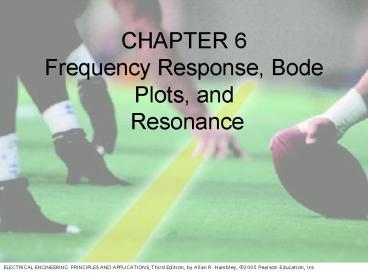CHAPTER 6 Frequency Response, Bode Plots, and Resonance - PowerPoint PPT Presentation
1 / 86
Title:
CHAPTER 6 Frequency Response, Bode Plots, and Resonance
Description:
A Bode plot shows the magnitude of a network function in decibels versus frequency using a logarithmic scale for frequency. – PowerPoint PPT presentation
Number of Views:238
Avg rating:3.0/5.0
Title: CHAPTER 6 Frequency Response, Bode Plots, and Resonance
1
CHAPTER 6Frequency Response, Bode Plots, and
Resonance
2
CHAPTER 6Frequency Response, Bode Plots, and
Resonance
- State the fundamental concepts of Fourier
analysis. - 2. Determine the output of a filter for a given
input consisting of sinusoidal components using
the filters transfer function.
3
3. Use circuit analysis to determine the
transfer functions of simple circuits. 4. Draw
first-order lowpass or highpass filter
circuits and sketch their transfer
functions. 5. Understand decibels, logarithmic
frequency scales, and Bode plots.
4
6. Draw the Bode plots for transfer functions of
first-order filters. 7. Use software to
produce Bode plots for more complex RLC
filters. 8. Calculate parameters for series
and parallel resonant circuits.
5
9. Select and design simple filter
circuits. 10. Design simple digital
signal-processing systems.
6
(No Transcript)
7
Fourier Analysis
All real-world signals are sums of sinusoidal
components having various frequencies,
amplitudes, and phases.
8
(No Transcript)
9
(No Transcript)
10
(No Transcript)
11
Filters
Filters process the sinusoid components of an
input signal differently depending of the
frequency of each component. Often, the goal of
the filter is to retain the components in certain
frequency ranges and to reject components in
other ranges.
12
Transfer Functions
The transfer function H(f ) of the two-port
filter is defined to be the ratio of the phasor
output voltage to the phasor input voltage as a
function of frequency
13
The magnitude of the transfer function shows how
the amplitude of each frequency component is
affected by the filter. Similarly, the phase of
the transfer function shows how the phase of
each frequency component is affected by the
filter.
14
(No Transcript)
15
Determining the output of a filter for an input
with multiple components
1. Determine the frequency and phasor
representation for each input component. 2.
Determine the (complex) value of the transfer
function for each component.
16
3. Obtain the phasor for each output component by
multiplying the phasor for each input component
by the corresponding transfer-function value. 4.
Convert the phasors for the output components
into time functions of various frequencies. Add
these time functions to produce the output.
17
(No Transcript)
18
Linear circuits behave as if they
- Separate the input signal into components having
various frequencies. - 2. Alter the amplitude and phase of each
component depending on its frequency. - 3. Add the altered components to produce the
output signal.
19
(No Transcript)
20
(No Transcript)
21
FIRST-ORDER LOWPASS FILTERS
22
(No Transcript)
23
(No Transcript)
24
(No Transcript)
25
(No Transcript)
26
DECIBELS, THE CASCADE CONNECTION, AND LOGARITHMIC
FREQUENCY SCALES
27
28
(No Transcript)
29
30
Cascaded Two-Port Networks
31
(No Transcript)
32
Logarithmic Frequency Scales
On a logarithmic scale, the variable is
multiplied by a given factor for equal increments
of length along the axis.
33
A decade is a range of frequencies for which the
ratio of the highest frequency to the lowest is
10.
An octave is a two-to-one change in frequency.
34
(No Transcript)
35
BODE PLOTS
A Bode plot shows the magnitude of a network
function in decibels versus frequency using a
logarithmic scale for frequency.
36
(No Transcript)
37
- A horizontal line at zero for f lt fB /10.
- 2. A sloping line from zero phase at fB /10 to
90 at 10fB. - 3. A horizontal line at 90 for f gt 10fB.
38
(No Transcript)
39
(No Transcript)
40
(No Transcript)
41
FIRST-ORDER HIGHPASS FILTERS
42
(No Transcript)
43
(No Transcript)
44
(No Transcript)
45
Computer-Generated Bode Plot
46
(No Transcript)
47
(No Transcript)
48
(No Transcript)
49
(No Transcript)
50
(No Transcript)
51
SERIES RESONANCE
Resonance is a phenomenon that can be observed in
mechanical systems and electrical circuits.
52
(No Transcript)
53
(No Transcript)
54
(No Transcript)
55
Series Resonant Circuit as a Bandpass Filter
56
(No Transcript)
57
(No Transcript)
58
(No Transcript)
59
(No Transcript)
60
(No Transcript)
61
PARALLEL RESONANCE
62
(No Transcript)
63
(No Transcript)
64
(No Transcript)
65
Ideal Filters
66
(No Transcript)
67
(No Transcript)
68
Second-Order Lowpass Filter
69
(No Transcript)
70
(No Transcript)
71
(No Transcript)
72
(No Transcript)
73
(No Transcript)
74
(No Transcript)
75
(No Transcript)
76
DIGITAL SIGNAL PROCESSING
77
(No Transcript)
78
Conversion of Signals from Analog to Digital Form
If a signal contains no components with
frequencies higher than fH, the signal can be
exactly reconstructed from its samples,
provided that the sampling rate fs is selected to
be more than twice fH.
79
(No Transcript)
80
(No Transcript)
81
Digital Lowpass Filter
82
(No Transcript)
83
(No Transcript)
84
(No Transcript)
85
(No Transcript)
86
(No Transcript)































